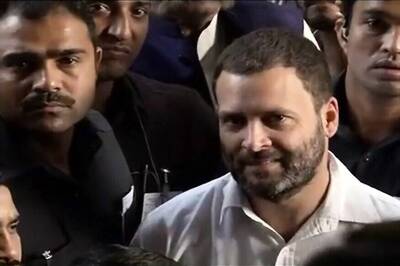
views
For a traditional diamantaire, Mehul Choksi is on unfamiliar territory. Unlike his brethren from the $10-billion diamond cutting and exporting business who haven’t moved from the old, crowded diamond hub near Opera House in South Mumbai, Choksi operates from the city’s latest financial district. Two years ago, he gave up eye glasses and the assortment table for a chic office to play host to high profile guests, mostly Bollywood actors. He talks of brands, advertising expenditure and balance sheet, something his hush-hush industry has often shied away from.
Even as his peers continue to hunch over the table sorting out prime diamonds, the 50-year-old college dropout — whose clothes come stitched from Hong Kong with his initials embroidered on them — talks passionately about making jewelry, branding and selling them through retail outlets. “The next LVMH (the international luxury group with brands like Louis Vuitton and Christian Dior) will be born out of India,” says Choksi, managing director of the Mumbai-based Gitanjali Gems.
Choksi is already the largest integrated diamond jewelry retailer in India with brands like Nakshatra, D’damas and Gilli under his belt. He also has over 150 retail stores in the US by virtue of two acquisitions his company made last year, which sell well known brands.
He has a flashy ambition. He is aiming to be the world’s biggest jewelry retailer, growing bigger than Tiffany, which had net sales of $2.86 billion last year and has over 200 exclusive stores; at the same time, create a group full of well known brands, something on the lines of LVMH, which owns 50 brands netting it over 17 billion euros in revenue in 2008. For Gitanjali, Choksi unabashedly talks of revenues of $5 billion from his 60-odd brands, from the current consolidated sales of $1.2 billion in the next “few years.”
By any standards, that’s a tall order. Even more so, if you read a little deeper into Gitanjali Gem’s financial statements for 2008-9. The company sold goods worth Rs. 2,700 crore, 40 percent of it on consignment basis for which it gets paid upfront. Its sundry debtors owed it Rs. 1,600 crore, nearly as much as its remaining sales. Its long term loans stood at Rs. 1,600 crore and the company had an inventory of Rs. 700 crore. A mere look would tell you that the company’s cash is not gainfully employed and any default from debtors may well send it into a financial quagmire.
Choksi says though export sales of diamonds were a problem last year due to the slowdown, his sales realisations have long led times. He also wants to be classified as a retail company, as he is making substantial investments in building a chain of stores and associated infrastructure. Says Choksi: “Our business model is changing and some of (the) legacy is reflected in the numbers.”
There is some proof to back up Choksi’s claim. Next week, Gitanjali is opening a sprawling 10,000 square feet retail outlet in a plush south Mumbai mall. He has leased up a dozen more places in the last couple of months when real estate was available cheap to enlarge his retail presence. “Our confidence stems from the fact that our retail jewelry business has been growing more than 20 percent even during the downturn. We want to be there when the tide turns,” says G.K. Nair, Gitanjali’s executive director and in charge of finance.
Though most of the growth in the jewelry business came in recent years, Choksi saw the writing on the wall pretty early. Choksi realized that he was in the lowest end of the value chain, whereas more than 70 percent of the additional value accrued to the companies that sold those diamonds in branded jewelry. According to the International Diamond and Jewelry Exchange, or IDEX, in 2006-07, rough diamonds of $7 billion in the mines were worth $19.8 billion after they were cut and polished by the likes of Gitanjali. They value increased exponentially to $73 billion when they got sold in stores across the world.
Today, jewelry accounts for 40 percent of Gitanjali’s sales but Nair expects that the diamond business to eventually contribute just 20 percent of its increased sales. The company’s retail jewelry sales are growing fast too, thanks to the fast growth of retailing through malls and shopping arcades. But the icing on the cake lies in the profitability. According to a senior industry official, diamond companies profit margins lie between 2-3 percent, compared to 9-12 percent for jewelry companies. Gitanjali’s net margins at 8 percent already seem to indicate that trend.
It wasn’t easy. In an industry known to work more on oral contracts than written ones, Choksi’s move to bring in a corporate-like structure at Gitanjali had been beset with hurdles.
It also didn’t help that the industry is eyed with suspicion and its detractors talk in hush tones about money laundering and “terror money” finding its way into the business. “Back then, about 15 years ago, if I had known the industry as well as I do today, I might have not taken up Mr. Choksi’s offer,” says Nair.
The initial public offering (IPO) in 2006 was a particularly difficult affair. Its two lead managers, known names in the financial world, backed out in the last minute citing “reputation” problems with the diamond industry. Gitanjali went ahead with the IPO with a new lead manager and mopped up the targeted Rs. 330 crore. A year later, the same two lead managers came back and asked to be part of Gitanjali’s latest fund raising initiatives — a $110 million foreign currency convertible bond and a $180 million global depository receipt. They were politely refused. Gitanjali had made a statement.
Choksi also had to go against the tradition and push his business through branding. Though the Gujarati businessman already had 15 brands under him by 1997, it was only after DTC — the trading arm of miner De Beers — introduced Nakshatra in India in 2000, that Choksi had an opportunity to hone his skills in actually building a popular brand.
DTC’s retailing model — giving consignment rights to its site holders like Gitanjali to sell the brand through family-owned retail shops — backfired. Its products didn’t have uniform prices and the site holders and the retailers were under no obligation to sell the brand in preference to their own jewelry items. After four years, Nakshatra had logged only Rs. 7 crore in annual sales. The South African company changed tack and handed over the management to Gitanjali Gems, the most experienced among the site holders in selling branded jewelry.
Realising that he needed to do something out of the box to drive Nakshatra, Choksi brought in Samsika Marketing Consultants. The Jagdeep Kapoor-led consultancy advised Choksi to use the fast-moving consumer goods model to sell Nakshatra, a blasphemous advice for the then marketing team that was full of jewelers. They revolted but Choksi ignored them. He got in a new marketing team with experience in selling FMCG products. He opened zonal offices, set up a team of designers, introduced new product lines and tied up with big retail chains like Shopper’s Stop to sell his brand. Over the years, the move has paid dividends.
In 2008, the Katrina Kaif-endorsed premium luxury brand had sales of Rs. 250 crore. This year, it is expected to hit Rs. 400 crore and become the biggest jewelry brand in the country. Last year, Gitanjali Gems completely bought out Nakshatra for Rs. 100 crore. “Today all our brands follow the FMCG model,” says Amrish Masalia, CEO of Brightest Circle Jewellery Pvt. Ltd., the Gitanjali subsidiary that owns Nakshatra. But Gitanjali’s scorching growth, from $300 million in 2005 to $1.2 billion in 2008, has got the industry hooked.
Now he wants to double the retail presence in the US. Similarly in China, where it has production facilities, it is planning to double its retail network to 100 stores. In West Asia, Gitanjali has tied up with Damas International to open 100 stories in another three years. There are talks about a billion dollar acquisition in the US.
Choksi has changed from a diamond trader to a globetrotting executive with the same penchant for board room discussions as for Page 3 parties attended by Bollywood celebrities (25 of whom are his brand ambassadors). The continued branding media blitzkrieg sucks out about Rs. 500 crore a year. Out of his many brands, only about five are profitable. Another three to four have broken even but not made considerable money.
Choksi never sounded more confident. “Tiffany is a brand for classes, but we have brands for masses. Each of my brands should have its own identity and not known for their association with Gitanjali Gems. Each day three to four outlets will be added and a new brand will be launched every few months.” The confidence is reflected in his move to increase prices of his brands when others were slashing to stimulate demand. For Mehul Choksi hasn’t believed in retaining the status quo.



















Comments
0 comment